Our journey from Alexandria to Cairo necessitated another early start, this time to get to the capital before the traffic hit the highway. It felt like we had been in Egypt for a week, when it had only been two days, but what a ‘two days’ it had been! It’s crazy how time ‘feels’ when you’re travelling on a holiday, and I love it!
Our first order of business once on the road was to ask our trusty driver and guide, Ayman, his advice on solving an EgyptAir problem that presented itself via an overnight email. He called the company office on his phone and handed it over to me, but the call kept cutting out, so we decided to wait until we arrived in Cairo, where we dropped our luggage at the hotel, and headed to the office in person.
Three bemusing hours were spent coping with phone outages, power outages and limited ATM withdrawals to access cash when the flight centre’s EFTPOS was down, all of which are a way of life here. It was a real blessing having Ayman with us throughout, to communicate our needs to the EgyptAir team trying to sort our flight problem. The details of the changes and rebooking are tedious and not worth the words here, but they are not a company I would choose to fly with again (but in Egypt, there is no choice!). Bottom line is – 5 hours to kill in Aswan airport!
So after our EgyptAir debacle, we were dropped at our hotel, the InterContinental Cairo Semiramis, to freshen up before our 3pm felucca ride on the Nile River.
The felucca ride in the afternoon was just what we needed, and not at all what we expected. We had an entire felucca to ourselves, with Ayman giving us the lowdown of what we could see on the shores. He always uses the sailors of this family of feluccas for his guests, and they have been sailing their whole lives. We zig-zagged our way across the river, with only the wind as currency. Our sailor was very skilled and it was a pleasure to watch him work. We appreciated the true down time, holiday time, when this really was already a travelling adventure rather than a holiday.
Memphis
Our first full day in Cairo was a big one with lots of inclusions, making the most of the lack of haze that can sometimes mar the views of the famous attractions. Memphis is often an overlooked site, especially for those who come to Cairo to ‘do it’ in one day. Have no idea how on earth they manage this! There are so many things to see in and around this city, that even our first three days only just allowed time for the main attractions and some extras.
This site centres on the remains of the ancient city of Memphis, the capital of Egypt during the Old Kingdom (2686 BC – 2181 BC). But this site was really all about Rameses II, and the gigantic statue that was found here, face down – thus his front is beautifully preserved (although archaeologists still haven’t found his legs or the top of his crown). The statue is made of limestone and measures about 10 metres in length.
One thing we are discovering about Egypt is that there are still so many unanswered questions as to how any of these magnificent things were created. How did they carve such perfect figures in granite when they had no metal tools? How did they get those stones up there without hydraulics? How did they get that cut into the stone in a perfect circle?
It’s also amusing to have the absolute honesty of Ayman about all that is not known, yet to have the signs at the sites making suppositions and him making noises and shaking his head at the assuredness of the ‘official signage’. Being an archaeologist, he is only interested in theories that have been proven – no evidence, no go.
Saqqara
Saqqara is the site of several important and distinctive pyramids, and was the necropolis for the ancient city of Memphis. Our first stop was the Mereruka Tomb, the largest tomb in the ‘street’, and the most elaborate of the non-royal tombs of Saqqara. The walls of its 33 chambers were covered with intricate carvings, all in beautifully rendered realism – fishing and hunting scenes, game playing, furniture making, and goldsmith working. Some still retained their original coloured paint. It was also fascinating to see the variety in the quality of different artists’ work in mirroring scenes on another wall. Even in Ancient Egypt, not all work was of the same quality.
The next stop was the Teti Pyramid, which provided our first underground visit. We climbed down via a steep ladder and did a bit of duck walking to get to the caverns at the end. I had thought it would be a tighter fit than it was, so we were both relieved when we discovered a lack of any real discomfort. The ceilings were painted black with white stars carved into them to create a night sky. The sarcophagus was gigantic, and also painted black. The old man who was showing us around kept up his refrain of, “Watch your head,” and offering to show us the ‘best bits’ of the tomb, ever helpful in the hope of a tip.
Zoser’s Step Pyramid (built in the third dynasty) is the oldest complete stone complex known. Before then all buildings were in wood, but Zoser wanted something more permanent. Another 16 Egyptian kings followed Zoser’s lead and built pyramids at Saqqara – his vision changed the course of architecture and set the path for the building of the Great Pyramids.
For many years, they could not find the entrance to the tomb of the Step Pyramid – this was clever design by the architect, who hid the entrance 86 metres from the pyramid itself to prevent looting. However, in their efforts to find the entrance, some muppet had the idea to take the blocks out of the bottom layer of the pyramid to gain access to the inside, and from there find the true entrance. They were successful in this goal, but of course, completely compromised the structure of the pyramid, causing a great crack through the middle of the structure. Twits. They have since made it structurally sound again, but the damage is still visible.
The highlight of this vast complex was the Pyramid of Unas. This unique tomb had painted alabaster walls with blue inscriptions contained within the walls themselves that could only be seen when a torch was held against the wall and the light projected into the stone. But that was not all, when all the lights were turned off in the tomb and a torch was shone alongside the two walls that flanked the sarcophagus, 3D shadow images could be seen on the wall. No one knows how this illusion is created, as when the lights are on, there is no suggestion at all of these images, and there is no evidence of an uneven surface to create the forms. It was as though the figures in the family representations were reaching out to us in the 21st century – wondrous and inexplicable; yet another one of the many mysteries surrounding the creations of Ancient Egypt, for which we have no answers.
Walking back to the Step Pyramid we couldn’t help but overhear a loud guide with a large group of tourists from a mixture of countries saying in his American accent how they could “now tell their friends back home that they have walked in the Sahara.” Ayman shook his head and made one of his disgruntled noises. He has given up correcting ignorant guides; they don’t take kindly to the education! The Sahara, he told us, is in Libya. “What we have in Egypt is the Western and Eastern Deserts!”
After this adventure we were in need of snacks, so we stopped for fresh falafel at a shop in the area where the farmers live. Ayman often stops here, but not all of his guests are willing to sample the local food from a venue considered unprepossessing to the western tourist. While the lovely woman serving us had some falafels left from the morning rush, she offered to make us fresh ones – yes, please! They were made with herbs and fava beans from her own garden, and everything was organic (in fact, all food in Egypt is organic – and you should see the size of the cabbages and cauliflowers currently in season!!). These would have to be the best falafels we have ever eaten, and I am sure it was all thanks to her home grown herbs.
The Great Pyramids of Giza
The security at The Great Pyramids, as with everywhere in Egypt, was full on and as it should be. Tourism is Egypt’s main industry and it has been dying a slow death because people have been scared to come here. And the fear is unwarranted – it is no worse than so many other countries that tourists regularly visit. Things are slowly starting to turn around, but it is a slow process.
Ayman began our tour with The Great Pyramid of Cheops (Khufu), the oldest and largest of the Giza Pyramids. We chose not to go into it, not because there was an additional cost, it was mainly because there is no decoration on the walls. What we saw earlier in the day was so extraordinary that we felt we didn’t need more underground time in an indistinct space. We did enter the low key and underwhelming first of the much smaller Queen’s Pyramids – mainly to see how the limestone was structured in the building of the tombs.
I found the camels quite mesmeric to look at; there was something graceful and serene about them. And their huge brown eyes and long eyelashes were adorable. This site was filled with camels and their handlers, as well as horses drawing carts and carriages. We were not impressed by the way the horses were treated. So many of them are undernourished and forced to run on the cobbles and skid about in their carts, which apparently often overturn with injuries to both horse and passengers. What was particularly hard to stomach was seeing a few that were clearly far too young to be doing this work – they were still foals, and they were pulling the load of a fully grown horse. Ayman said that due to the drop in tourism in recent years, so many of the handlers do not have the money to feed their horses properly. Some who once had say three or four horses, let some of them starve to feed the one or two they wanted to keep. Very sad.
From Cheops we drove around past the Pyramid of Kafre to where there was the perfect afternoon view of six of the pyramids, and where we met yet another dude known to Ayman who lined up a camel ride to see the nine pyramids all in one view. Artif was the owner of the camels, and his son, Bulla, took us out. This 17 year works the tourists nicely, with a handsome smile, charm and a cheeky sense of humour. When he got the camels on the ground with the pyramids in the background we handed him our camera and phone for him to take the obligatory tourist shots. He slung them over his shoulder and said ‘Bye bye’, pretending like he was about to walk off with them. Corny, but funny as he chortled and waved his hand, like, ‘just kidding.’
The camel ride itself was much more comfortable than the one we had in India, and it was about the same amount of time in the saddle. Maybe the saddles themselves made the difference. I was patting the shoulder of the camel I was riding and when I paused, he turned his head and nudged my left foot in the stirrup. When I told Ayman this, he said, they don’t get affection like that from people. Apparently, there are many young camel handlers and trainers who mistreat them, and Ayman said the older men try to tell them that the animals never forget, and one day, they will pay for that abuse. Good!
Clearly one of the unexpected delights of this trip was the time we were spending with our guide, Ayman. We loved the positive and joyous way he interacted with so many people, strangers and friends. When leaving Giza he gentling nudged a security guard with his car, who jerked his face up with a filthy look ready to deal with the inept lout, and then burst into a smile when he saw who the driver was. He honked at a camel driver crossing the street who also glared, then saw it was Ayman, and it was ‘all good.’ Everyone loves him, and it’s easy to see why.
Our Cairo adventure continues…
Accommodation: InterContinental Cairo Semiramis [See here for a detailed account of our time at the Semiramis.]
Tour Guide: Ayman Ahmed Tour Guide and TA Reviews
Read our full Cairo story here:
Part 1 (current): Memphis, Saqqara & The Great Pyramids
Part 2: Coptic Cairo, Islamic Cairo & Egyptian Museum
Click on any image below to view as gallery
- Camels crossing the road, Giza, Egypt
- Closeup of Sphinx rear, Giza, Egypt
- The rear of The Great Sphinx, Giza, Egypt
- The Great Sphinx, Giza, Egypt
- Ayman used for scale for a single block of stone, The Great Pyramids of Giza, Egypt
- Concert seating, The Great Pyramids of Giza, Egypt
- Farewelling our camels at The Great Pyramids of Giza, Egypt
- Camel shadows, The Great Pyramids of Giza, Egypt
- Nic in traditional scarf with Bulla, The Great Pyramids of Giza, Egypt
- Photoshoot at The Great Pyramids of Giza, Egypt
- Nic and John with the The Great Pyramids of Giza in the background
- Camera trickery, The Great Pyramids of Giza, Egypt
- Bulla and his camels, The Great Pyramids of Giza, Egypt
- Camel trek, The Great Pyramids of Giza, Egypt
- Nic and John astride camels at The Great Pyramids of Giza, Egypt
- Camel closeup with pyramid background, Giza, Egypt
- Viewing area for The Great Pyramids of Giza, Egypt
- Camels at Cheops, Giza, Egypt
- Chatty camel, The Great Pyramids of Giza, Egypt
- Three in a row, The Great Pyramids of Giza, Egypt
- Exiting the Queen’s Pyramid, Giza, Egypt
- Inside the Queen’s Pyramid, Giza, Egypt
- John and Nic and the Great Pyramid of Cheops, Giza, Egypt
- On the stairs of the Great Pyramid of Cheops, Giza, Egypt
- Watching our cartouche being made at Topaz Bazaar, Cairo, Egypt
- Hand made cartouches at Topaz Bazaar, Cairo, Egypt
- Hauling foliage, Cairo Egypt
- Camel transport, near Saqqara, Egypt
- Fresh falafel, while we wait, near Saqqara, Egypt
- Appearance of undulating wall, Pyramid of Unas, Saqqara, Egypt
- 3D images in Pyramid of Unas, Saqqara, Egypt
- Step Pyramid and camels, Saqqara, Egypt
- The Step Pyramid of Zoser, Saqqara, Egypt
- Tomb exit, Saqqara, Egypt
- Desert road, Saqqara, Egypt
- Cow and owner, Egypt
- Street near Memphis, Egypt
- Smaller Sphinx, Memphis, Egypt
- Smaller statue of Rameses II, Memphis, Egypt
- Tapestries for sale, Memphis, Egypt
- Rameses II statue, Memphis, Egypt
- Fruit stall, Cairo, Egypt
- Cairo taxis, Egypt
- Morning in Cairo, Egypt
- Cairo commute
- Nile River palms in Cairo
- Walking by the Nile River, Cairo
- Felucca moorings, Nile River, Cairo
- Rowing on the Nile, Cairo
- Nic and John, felucca sailing on the Nile, Cairo
- Windsurfer on the Nile, Cairo

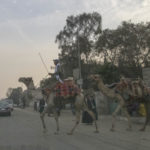
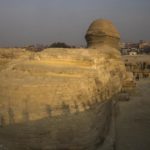
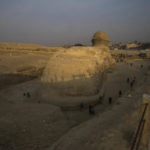
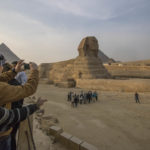


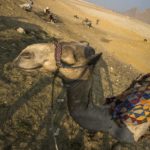
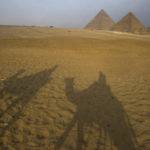
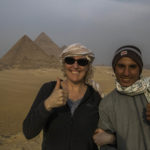
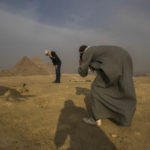
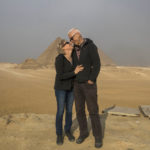
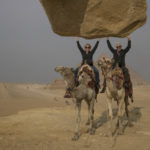
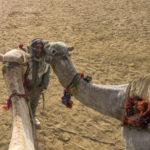
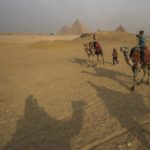
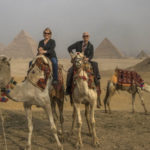

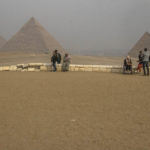
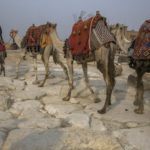
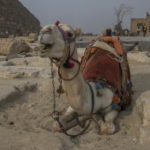
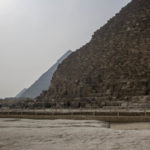
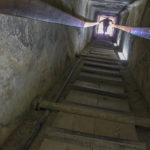
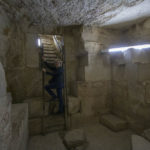
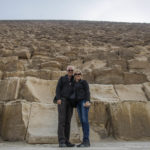
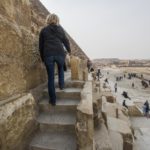
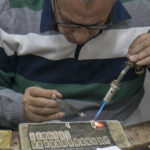
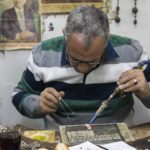
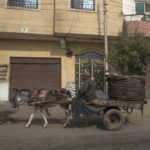
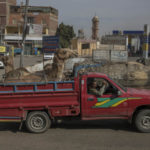
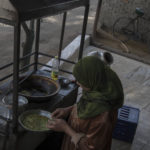
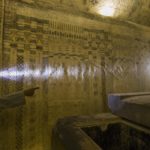
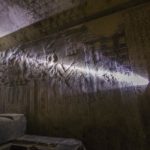
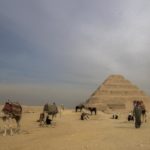
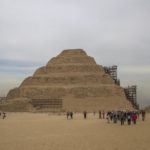
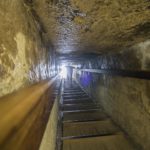
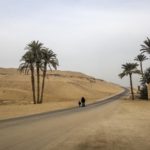
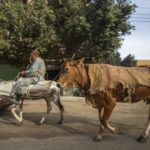
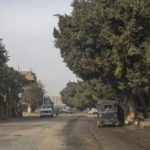
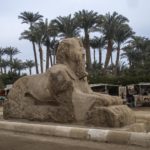

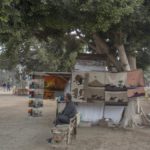
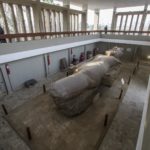
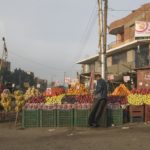

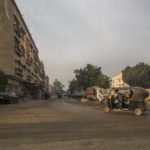


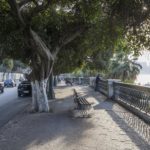
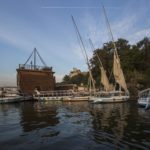

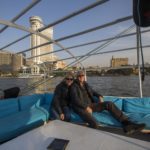

Pingback: InterContinental Cairo Semiramis – bontaks travels